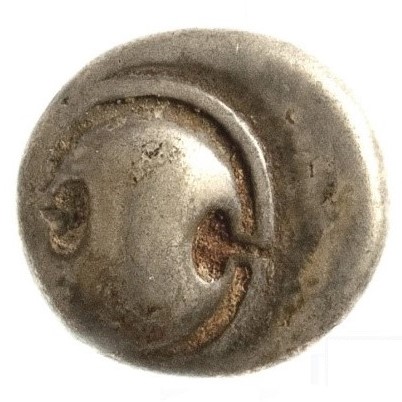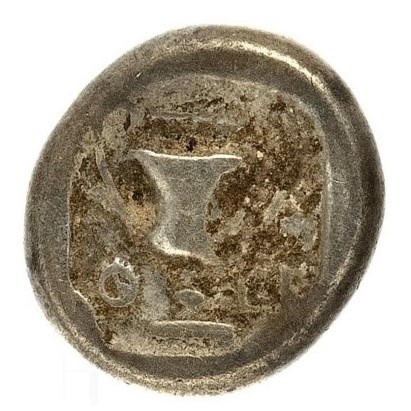Title: Hemidrachmon of Thebes, Boiotia - 1980.07
Acquisition number: 1980.07
Author or editor: Douglas Kelly
Culture or period: Classical Greece.
Date: c. 425 - 375 BC.
Material: Metal - Silver
Object type: Coins - Greek
Dimensions: 12mm (w)
Origin region or location: Greece
Origin city: Thebes.
Display case or on loan: 5
Keywords: Coin, Greek, Thebes, Boiotia, hemidrachmon, Dionysios
Classical Numismatic Group, The BCD Collection of the Coinage of Boiotia Auction IX [10 January 2006], New York, Triton, 2006), 408 - 12.
Sylloge Nummorum Graecorum, Copenhagen, The Royal Collection of Coins and Medals, Danish National Museum, repr. edn (West Milford, NJ, 1981-), 289 - 290.
O. Hoover, Handbook of Greek Coinage 13 vols (Classical Numismatic Group, Lancaster, PA, 2009-2013), 4.
B.V. Head, On the Chronological Sequence of the Coins of Boeotia (London, 1881), p. 36, class β, πλ. III, 7.
1980.07
Hemidrachmon of Thebes, Boiotia
Silver, 2.67 g. 12 mm. c. 425-375 BC.
Obv.: Boiotian shield.
Rev.: Kantharos and, above, club. Visible to left is the initial Θ (for Thebes). Traces of EB to right.
‘It often happens in Greek history that the numismatic problems do not sensibly diminish in proportion to an increase in our knowledge of the political history of the mint of origin’ (C.M. Kraay, Archaic and Classical Greek Coins (London, Methuen, 1976). 112), with reference to the coins of Boiotia.
For long periods of their history the cities of Boiotia were united in a federal state centred on Thebes. At other times, some or all the Boiotian cities were independent from the federal state. Coins from Boiotia bear either the initials ΒΟΙΟ for ‘Boiotians’, ΘΕ for ‘Thebans’, or the initials of other Boiotian cities, such as ‘Τ(Α) for ‘Tanagraians’ and ERXO for ‘Orchomenians’.
The standard silver coin issued in Boiotia was the didrachmon or two-drachma piece equivalent in weight to an Aiginetan stater. Smaller denominations like this hemidrachmon or quarter-stater are much less common. The Aiginetan standard shows that this coin belongs to the period before Alexander the Great broke up the Boiotian federal state and wiped out Thebes in 336 BC.
In spite of unresolved difficulties, there are good grounds for dating coins like this one to a period from the late fifth century, when the Boiotian federal state was in existence, down to its dismemberment in 387/6 under the Spartan-dictated Peace of Antalkidas. The starting date of ‘c. 426’ is notional.
The ox-hide shield stretched over a wooden frame with a convex front and two curved openings at the sides was the symbol of the Boiotians (Greek bous ‘ox’ was naturally, but not etymologically, associated with Boiotia). This type of shield seems to have been a sacred object. It was not used in the warfare of historic times.
The high-handled kantharos, or drinking cup (and, on other specimens, the amphora), was a civic emblem of Thebes, which was renowned as the birthplace of Dionysos, god of wine. The hero Herakles was also born at Thebes (in some accounts) and the club was his badge. Both Dionysos and Herakles had important cults at Thebes. Herakles’ club was the symbol painted on the shields of the Boiotians and even of some of their allies at the battle of Mantineia in 362 BC (Xenophon, Hellenika 7.5.20).
B.V. Head, On the Chronological Sequence of the Coins of Boeotia (London, 1881) is partly out-of-date but still useful.
Classical Numismatic Group, The BCD Collection of the Coinage of Boiotia Auction IX [10 January 2006], New York, Triton, 2006), 408 - 12.
Sylloge Nummorum Graecorum, Copenhagen, The Royal Collection of Coins and Medals, Danish National Museum, repr. edn (West Milford, NJ, 1981-), 289 - 290.
O. Hoover, Handbook of Greek Coinage 13 vols (Classical Numismatic Group, Lancaster, PA, 2009-2013), 4.
B.V. Head, On the Chronological Sequence of the Coins of Boeotia (London, 1881), p. 36, class β, πλ. III, 7.

